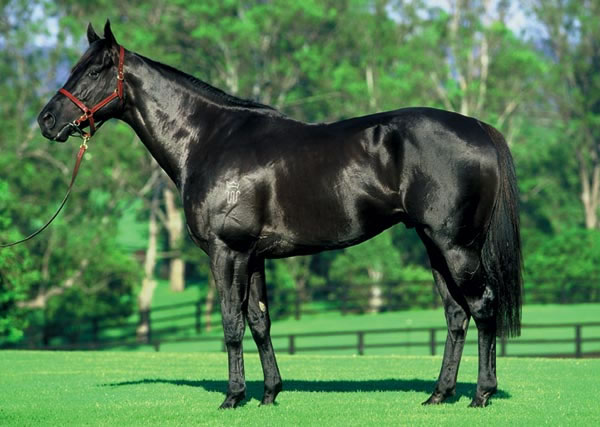
|
The Colorful Thoroughbred The Thoroughbred has a remarkably colorful genetic palette, ranging from ordinary bays to dazzling dominant white pintos. This page will delve into the mechanisms behind the colors as well as dispel some common misunderstandings about Thoroughbred color. For a more in depth discussion of equine color genetics in general, please see my main horse color page. Most of the photos here are ones I saved on my computer ages ago to use as reference photos for my artwork, so I don't know who some of the photos are by. If you see one of yours, please let me know, and I will be more than happy to list you as the photographer and add a link to your webpage or email if you have one. Also, I'm always interested in seeing pix of unusually colored TBs, so feel free to email me if you have a unique picture to share. Thanks! Along with the two base colors, chestnut and black, the Thoroughbred gene pool also includes agouti (bay), brown, grey, cream (palomino, cremello, buckskin, perlino, smoky black, and smoky cream), frame overo, splash white, sabino, dominant white, manchado, rabicano, and due to a recent mutation, what appears to be true roan. |
| Black is a rare color for Thoroughbreds, even though it is dominant to chestnut, the other base color. Pictured at right is the Aussie Champion Lonhro, a magnificent true black Thoroughbred stallion. True black horses will not have any brown hairs in their coat, unlike brown or dark bay horses, who may look black, but who usually have brown hairs on their muzzles, flanks, and inner forearms and thighs. Some black horses will fade with sun exposure---usually observable as brown hairs in the mane and tail---but it is only temporary, much like human hair will lighten in the summer. (Photo by ?) |
 |
| Chestnut is recessive to black (and all black-based colors). Chestnuts vary in shade in from a light golden color to red to liver. Some even have have flaxen manes and tails. |
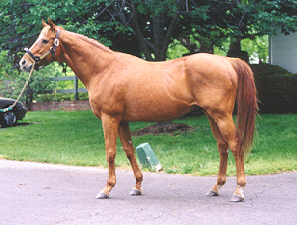 This is Affirmed, a golden chestnut. |
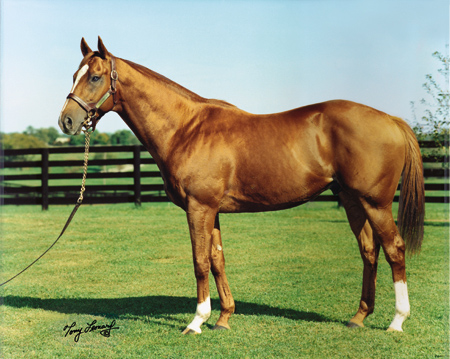 This is a Rahy, a slightly darker golden chestnut. |
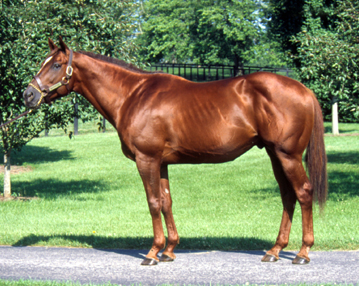 This is Horse Chestnut, a red chestnut. |
 This is Giant's Causeway, a liver chestnut. |
The Modifiers
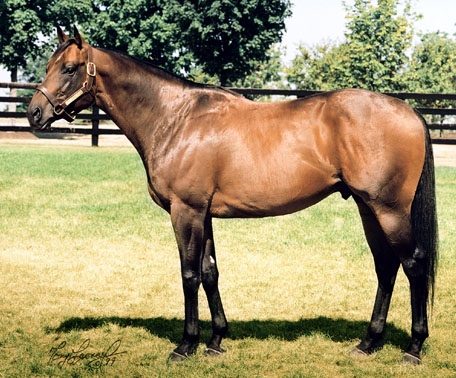 |
Bay is the most common color of Thoroughbreds, and it is actually a modification of the black base color. The agouti gene acts to lighten the hairs on the body, but it does not affect the legs, mane or tail, which is why they remain black. Agouti acts only on black body hairs, so a chestnut horse can carry the gene and pass it along to its offspring, but because chestnuts have no black hairs, the agouti gene has no observable effect on the coat. Pictured at left is Touch Gold, a light bay. (Photo by Tony Leonard) |
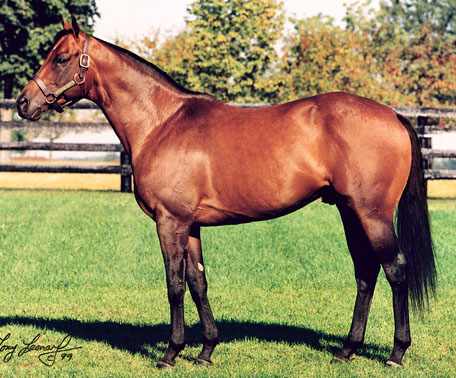 |
Bay comes in many shades, including a lovely reddish shade often referred to as blood bay or bright bay. Awesome Again is a nice example of this color. (Photo by Tony Leonard) |
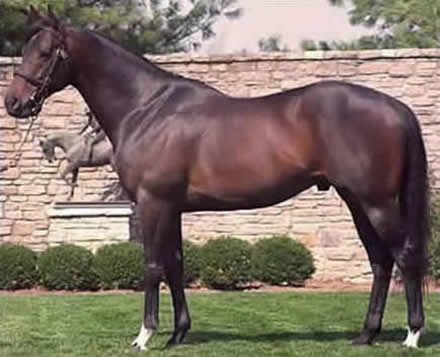 |
Biancone is an excellent example of dark bay. (Photo by Coolmore) |
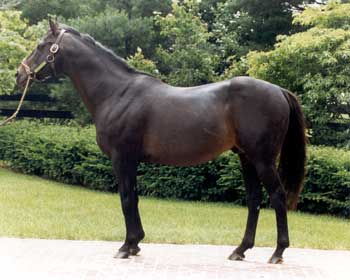 |
Brown is also a common color in Thoroughbreds..Like bay, it is a modification of the black base coat by an allele located at the same locus where agouti would be present. Horses that are bay carry the agouti allele in either the homozygous dominant form [AA] or the heterzygous dominant form [Aa]. Horses that are not bay are considered 'aa.' Brown horses have been genetically tested to determine that they do not carry 'A' or 'a' but an allele present at the same locus known as 'At.' Thus they are neither bay or just black, but rather something else entirely, namely "brown." Seattle Slew was great example of this color. Brown horses have a black coat except for telltale brown hairs on their muzzles, flanks, and inner forearms and thighs. (Photo by Anne Eberhardt) |
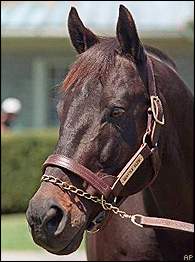 |
A headshot of Slew, showing his (slightly sunbleached) black coat and lighter muzzle. (Photo by Anne Eberhardt) |
The Cream Dilution
| Unlike agouti, which can only act on the black gene, cream can modify any color it acts in conjunction with, though it is most commonly seen combined with chestnut, bay, and black. The cream gene is an incomplete dominant, meaning it is always expressed when it's present, but it acts differently in its heterozygous (1 copy of the gene) and homozygous (2 copies of the gene) states. Simply put, horses with one copy of the cream gene will have a diluted coat; horses with 2 copies will have a doubly diluted coat. Double dilutes always have blue eyes. The cream gene does not effect black hairs in it's single form, only in it's double form. |
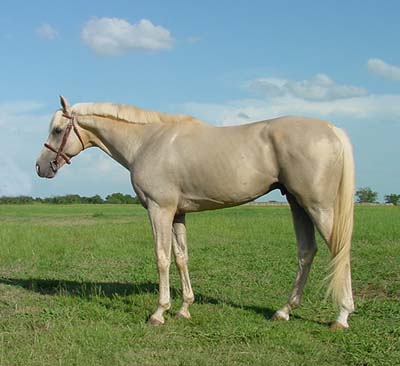 |
When chestnut is combined with one cream gene, the resulting color is palomino. Just like chestnut, palomino ranges in intensity and shade. King's Ransom, pictured at left, is an example of a pale palomino. He is owned by Stoneybrooke Farm. (Photo by Milynda Milam.) |
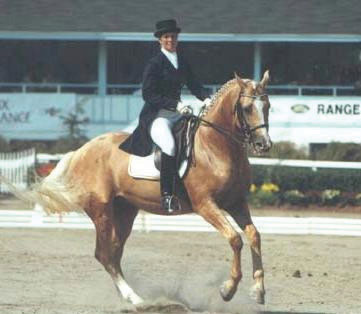 |
The late Glitter Please, pictured at left, was a lovely darker palomino. He was the only palomino colored TB stallion in the world with an impressive show resume in FEI dressage. (Photo by Terri Miller.) |
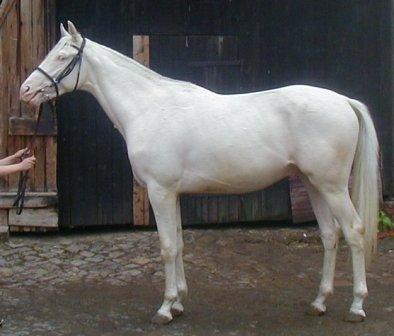 |
This is RFF The Alchemist, a cremello son of King's Ransom, pictured above. Cremello occurs when a chestnut coat is combined with 2 cream genes (one from each parent). Though he looks white, he is actually a very pale cream color. White markings are discernable on double dilutes. (Bred by Red Fox Farm, owned by Gestuet Falkenhorst, photo by Gestuet Falkenhorst.) |
 |
When the cream gene is combined with bay, the result is buckskin.
Like the agouti gene, the cream gene does not affect black hairs, so only
the brown hairs of the coat are diluted to the golden color. (Pictured
at left is Brilliant Intuiten of Frazer's
Stable.) |
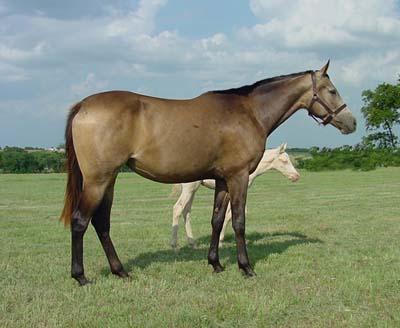 |
Like palomino, buckskin can vary in shade. This mare, Golden Belle, looks like a light bay, but is in truth a sooty buckskin. She is pictured here with her cremello colt by King's Ransom. (Bred, owned, and photographed by Red Fox Farm.) |
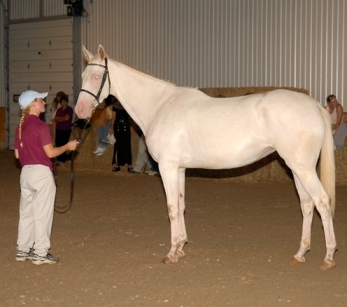 |
Perlino occurs when a bay coat is combined with 2 cream genes (one from each parent). Two cream genes do dilute the black points of the horse, often leaving a reddish cast to the points. RFF Platinum, a rare perlino daughter of RFF King's Ransom (by Milkie's Desire) out of a Glitter Please daughter. |
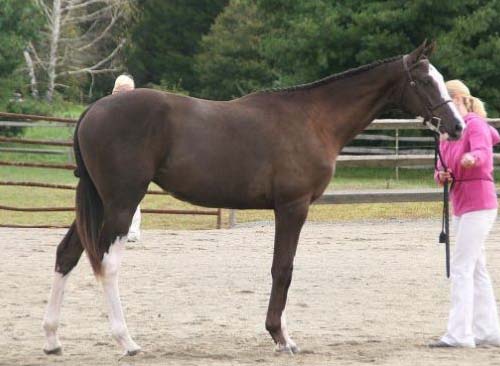 |
As is mentioned above, a single creme gene has very little, if any, effect on a black coat, so smoky blacks are hard to identify unless their pedigree is known or unless they produce cream dilute foals. This is TCF Nightlight, the first known smoky black TB. She is by Guaranteed Gold out of Puchi Trap (by Puchilingui). |
 |
This horse is also not a TB (he's an Akhal-Teke), but he is a smoky cream. Notice how his black coat has been dramatically diluted because he carries 2 cream genes. TCF Palladium is the first known smoky cream TB, and foal pictures of him can be seen on the True Colors Farm website. |